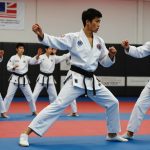Overview of Video Feedback Techniques in Taekwondo
The integration of video feedback techniques into taekwondo is reshaping how practitioners improve their skills. At its core, video feedback involves capturing athletes in action, allowing for a detailed analysis of movements. It provides a visual element that enables both athletes and coaches to identify strengths and weaknesses. This form of feedback is crucial for refining techniques, offering insights that are not always evident in real-time observation alone.
Historically, taekwondo training relied heavily on direct coach-athlete interaction and repetition. The advancement of technology in taekwondo training, though, has transformed these traditional methods. Over the years, video feedback has become a staple in training regimens, paving the way for innovation in teaching methodologies. Coaches can now provide specific visual examples of techniques, fostering an environment of enhanced learning.
Also read : Ultimate guide to sparring safety protocols in uk taekwondo clubs: essential tips for a secure experience
The importance of video feedback in taekwondo extends beyond training sessions. It is instrumental in developing skills, allowing athletes to visually monitor their progress over time. By reviewing footage, practitioners can adjust their tactics and techniques, leading to more effective and efficient skill acquisition. Ultimately, video feedback becomes a tool for progression, ensuring that athletes continue to evolve and excel in their sport.
Benefits of Video Feedback in Taekwondo Training
Incorporating video analysis into taekwondo training offers significant benefits, enhancing both individual and collective performance. This technique provides athletes with improved visual feedback, allowing them to identify and correct even minute technical flaws. Understanding one’s own movements through recorded footage aids significantly in refining techniques, beyond what verbal instructions achieve.
Topic to read : Enhancing fencing excellence: how biomechanical analysis transforms techniques for uk athletes
Performance monitoring becomes more effective with video analysis, as it facilitates precise goal-setting for athletes. This approach allows coaches to pinpoint areas requiring improvement, track progress visually, and tailor training regimens accordingly. Consequently, athletes become better equipped to focus their efforts on specific goals.
An often understated advantage is how video feedback can enhance athlete engagement and motivation. Reviewing footage of themselves, athletes get a tangible sense of how their techniques are evolving over time. This visual representation inspires athletes by showing clear developmental progress, reinforcing their motivation to continue training and improving.
Thus, video analysis not only aids in pinpointing areas for development but also plays a crucial role in motivating athletes. With a structured and engaging approach, taekwondo practitioners are more likely to experience significant performance enhancements, making video feedback an indispensable component in modern taekwondo training programs.
Practical Applications of Video Feedback in Training
Video feedback techniques have revolutionized modern taekwondo training by offering valuable insights into an athlete’s performance. The use of video analysis provides coaches with meaningful data to enhance their coaching strategies and maximise training outcomes. These applications manifest in structured session planning, real-time sparring analysis, and comprehensive post-training reviews.
Session Planning and Structuring
When planning a training session, coaches can utilise video feedback to identify specific focus areas. This targeted planning ensures that sessions address individual athlete weaknesses effectively, leading to more personalised and impactful training experiences.
Real-time Analysis during Sparring Sessions
During sparring sessions, real-time video analysis becomes a powerful tool. Coaches and athletes can assess movements on the spot, allowing immediate correction and adjustment. This instant feedback loop not only fosters quicker technique refinement but also enhances the athlete’s ability to respond dynamically in live situations.
Post-Training Review Mechanisms
Post-training reviews with video feedback allow athletes to revisit their performances critically. Engaging in systematic video review solidifies learning, helping athletes understand their performance from an external perspective. Integrating these reviews into ongoing assessments cultivates a continuous improvement mindset, ultimately boosting athlete proficiency and competitiveness.
Case Studies: Success Stories from the UK
In the UK, several notable taekwondo clubs are harnessing the power of video feedback techniques to drive remarkable improvements in performance. These clubs serve as prime examples of taekwondo training innovation, demonstrating how technology can transform traditional martial arts training.
Prominent clubs such as TagSports, Birmingham Taekwondo Academy, and London Elite have integrated comprehensive video analysis into their routines. Coaches there report significant athlete advancements, articulating how video feedback empowers practitioners to visualise their progress. An engaging result surfaced when TagSports revealed their athletes regularly improved by 20% in competitive scenarios after consistently applying video feedback techniques. This data underscores the value of such technology in scientific terms as well.
Testimonials from athletes confirm the tangible motivations derived from seeing their growth trajectories through video. One Birmingham athlete expressed renewed vigour in training, attributing competitive success partially to these adaptations.
The encompassing embrace of video feedback techniques within the UK’s taekwondo community showcases how thoughtful application leads to enhanced success and athlete satisfaction. These clubs’ stories provide compelling evidence of the measurable improvements achievable with a strategic focus on video analysis.
Tools and Technology for Video Feedback
Sporting endeavours, like taekwondo, greatly benefit from state-of-the-art video analysis tools designed specifically for performance enhancement. Opting for the right combination of technology in sports is crucial. Popular software such as Dartfish, Coach’s Eye, and Hudl Technique have transformed training regimens, offering sophisticated features for detailed analysis.
Dartfish stands out for its analytical capabilities, providing frame-by-frame breakdowns and annotations, which significantly aid in technical corrections. Alternatively, Coach’s Eye is renowned for its user-friendly interface, enabling quick feedback through slow-motion replays and side-by-side comparisons. Hudl Technique melds advanced video analysis with cloud-based storage, allowing for seamless sharing and collaborative reviews within taekwondo teams.
Choosing the optimal recording hardware is vital. Smartphones with high-definition cameras are accessible and versatile but may lack the precision of dedicated video cameras like the GoPro, which excels in capturing action-packed sessions with remarkable clarity.
When selecting video analysis tools, factors like budget, technological know-how, and specific training objectives should be paramount. An informed decision empowers taekwondo coaches and athletes to maximise the benefits of video feedback, ensuring continuous skill development and performance enhancement.
Tips for Implementing Video Feedback Techniques
Integrating video analysis into training sessions can elevate coaching effectiveness and athlete performance. To begin, choose appropriate moments for recording, aligning with your training objectives. This ensures that the feedback is well-timed and relevant. Set clear goals for each session to utilise video feedback effectively, focusing on key techniques or areas for improvement.
During video reviews, maintain a structured approach by highlighting specific technical elements. Use these observations to foster a constructive discussion, encouraging athletes to self-reflect and identify their strengths and areas for development. Incorporate side-by-side comparisons of current and past performances to visually demonstrate progress, reinforcing a culture of continuous learning.
For optimal results, coaches should adapt best practices for conducting video analysis. This includes creating a feedback-friendly environment, promoting open dialogue between coach and athlete, and praising improvements to boost confidence. Regularly schedule video reviews, ensuring they are part of an athlete’s routine, as this consistency is key to enhancing skills over time.
Cultivating a culture of feedback involves encouraging athletes to ask questions and explore different perspectives. By making video analysis a collaborative process, both coaches and athletes can contribute to a more dynamic and effective training experience.











